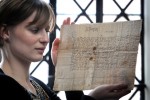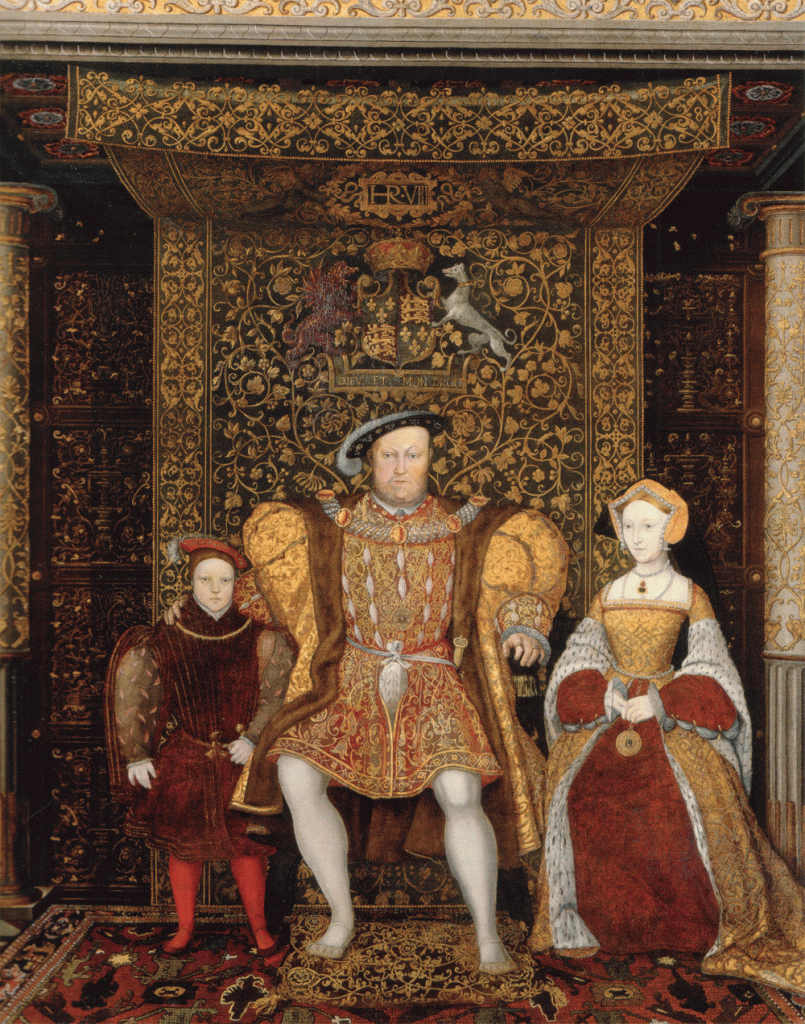 Katie Taylor, the house steward of National Trust estate Dunham Massey, was going through a folio of letters in storage when she unexpectedly came across two royal letters, one from King Henry VIII, the other from his third wife Jane Seymour. Most of the letters kept in the home were transferred to the John Rylands University Library at the University of Manchester after the last Earl of Stamford died in 1976 bequeathing the estate to the National Trust. Taylor was almost sure she recognized the signatures as those of Henry and Jane, but to be certain the National Trust called in an expert from John Rylands Library to examine them. He confirmed that they are indeed genuine.
Katie Taylor, the house steward of National Trust estate Dunham Massey, was going through a folio of letters in storage when she unexpectedly came across two royal letters, one from King Henry VIII, the other from his third wife Jane Seymour. Most of the letters kept in the home were transferred to the John Rylands University Library at the University of Manchester after the last Earl of Stamford died in 1976 bequeathing the estate to the National Trust. Taylor was almost sure she recognized the signatures as those of Henry and Jane, but to be certain the National Trust called in an expert from John Rylands Library to examine them. He confirmed that they are indeed genuine.
Taylor notes that the letters are in excellent condition, a notable feat given that they were written decades before the first Dunham Massey house was built. They were written on thick, strong paper and stored flat for centuries. Obviously generations of Dunham families treasured them and kept them safe.
 The letter from Henry VIII was written on February 10th, 1543 to George Booth, Esq., the grandfather of the Sir George Booth who built the first Dunham Massey estate in 1600. In it the king exhorts Booth to draft all the men he can muster to fight against the Scots who have done Henry, Britain and his people “manifold injuries, wrongs and displeasures.” Booth is to count the final numbers of cavalry, archers, billmen (infantry bearing hooked polearms called bills) and all other stand-out fighters then write to Henry Radclyffe, the Earl of Sussex and the king’s second cousin, letting him know exactly what forces he can expect Booth to bring him.
The letter from Henry VIII was written on February 10th, 1543 to George Booth, Esq., the grandfather of the Sir George Booth who built the first Dunham Massey estate in 1600. In it the king exhorts Booth to draft all the men he can muster to fight against the Scots who have done Henry, Britain and his people “manifold injuries, wrongs and displeasures.” Booth is to count the final numbers of cavalry, archers, billmen (infantry bearing hooked polearms called bills) and all other stand-out fighters then write to Henry Radclyffe, the Earl of Sussex and the king’s second cousin, letting him know exactly what forces he can expect Booth to bring him.
The full text of the letter transcribed in modern English:
By the King
Trusty and well-beloved we greet you well, letting you know that forasmuch as by the manifold injuries, wrongs and displeasures done unto us, our realm and our subjects by the Scots, we have been forced lately to enter into open war and hostility with the same, which we intend and purpose, god willing (unless the nobles of Scotland conform themselves to reason), to prosecute with such force as shall redound to our honour and to the commonwealth of our realm and subjects. To the intent that we may better know the forces of our said realm and thereby put the same in such order and readiness as they may serve us in this enterprise as the case shall require, we have thought meet and necessary to have special musters taken of all our people and thereupon to have all such plan and perfect certificate made as shall declare what be trusted to in that behalf. Wherefore our pleasure and commandment is that you, by virtue and authority hereof, shall with all convenient diligence take the musters of all the able men, both horsemen and footmen, which you can make and furnish, both of our tenants inhabiting upon farms, holdings and tenancies within any office under us of which you have the stewardship, if you have any such, and also of your own servants and tenants dwelling upon your own tenancies. And the same so taken, to certify in writing to our right trusty and right entirely beloved cousin and counsellor the Duke of Sussex, lieutenant general in the northern areas, with all possible diligence, with a special note and declaration to be expressed in the said certificate, how many of the said persons are furnished with horses able to occupy [carry] a spear or javelin, how many are archers and how many billmen, and how many principal men may be picked out of every sort of the whole number. Forcing [taking care] that in these musters and certificate you do not meddle in any way with any mariners, forasmuch as we intended to reserve the same of our furniture by sea [i.e. navy], and that you put all the same readiness as they [to] set forth in one hour’s warning, whenever you receive commandment from our said cousin in that behalf. And these our letters shall be your sufficient warrant and discharge herein accordingly. Given under our signet [seal] at our Palace of Westminster the 10th day of February, the 34th year of our reign.
 The second letter was written on behalf of Queen Jane Seymour and is a birth announcement. It’s dated October 12th, 1537, the actual birth day of Henry’s only (legitimate) son, the future Edward VI, and was not written by Jane herself. She was in no state to be writing birth announcements after two days and three nights of labor, nor would she ever be again. She died just 12 days later, probably from an infection contracted during childbirth.
The second letter was written on behalf of Queen Jane Seymour and is a birth announcement. It’s dated October 12th, 1537, the actual birth day of Henry’s only (legitimate) son, the future Edward VI, and was not written by Jane herself. She was in no state to be writing birth announcements after two days and three nights of labor, nor would she ever be again. She died just 12 days later, probably from an infection contracted during childbirth.
The full text of her letter in modern English:
By the Queen
Trust and well beloved, we greet you well. And forasmuch as by the inestimable goodness and grace of Almighty God, we have been delivered and brought to child-bed of a Prince conceived in most lawful matrimony between my lord, the King’s Majesty, and us, doubting not but that for the love and affection which you bear unto us and the commonwealth of this realm the knowledge of which you should be joyous and glad tidings unto you, we have thought good to certify you of the same, to the intent that you might not only render unto God condign thanks and praise for so great benefit, but also pray for the long continuance and preservation of the same here in this life to the honour of God, joy and pleasure of my lord the King and us, and the universal peace, quiet and tranquility of this whole realm. Given under our Signet at my lord’s manor of Hampton Court, the 12th day of October.
Both letters are now on display at Dunham Massey as part of its new “Faithful and Obedient” exhibition, which, in honor of Queen Elizabeth II’s Diamond Jubilee year, documents the history of relations between the English monarchs and the Dunham Massey families. The exhibit is open from Saturdays to Wednesdays, 11 AM – 5 PM.
